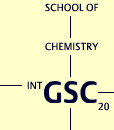 |


![]()
Name:
Lars Büter
Diploma / M.Sc degree:
Westfälische Wilhelms-Universität Münster, Germany
(June 2012)
PhD Project:
Differential Labeling of Biomolecules based on Electrochemically Generated Reactive Intermediates
Abstract of Research Project
Electrochemistry (EC) has proven to be a valuable tool for the simulation of oxidative drug metabolism. The formation of reactive quinoid species via dehydrogenation leads to a Michael type addition of these electrophilic structures to nucleophilic compounds. Therefore, modification of proteins and peptides which contain the amino acid cysteine can easily be achieved due to the nucleophilic nature of the free thiol groups. Their labeling enables the determination of cysteine containing proteins. Thus, the identification of these proteins is simplified. Differential labeling of the cysteine moieties with the isotope labeled and native form of a generated oxidation product results in a mass shift between the labeled biomolecules. Based on this mass shift, the labeled molecules can be identified easily.
The hyphenation of an electrochemical cell to electrospray ionization mass spectrometry (ESI MS) enables the immediate detection of the generated oxidation products. Applying a potential ramp from 0—2500 mV and the presentation of the data in form of three dimensional mass voltammograms provides a broad overview on the generated oxidation products. Furthermore, a fast and efficient optimization of the EC and MS conditions is possible for each compound.
An extension of the instrumental set up by means of liquid chromatography (LC) enables the on-line generation, separation and identification of modified proteins. By employing a switching valve for the injection, the EC oxidation and the LC separation conditions can be optimized independently regarding the flow rate, solvent composition and pH.
In first experiments, the two phenolic species phenol and paracetamol were electrochemically oxidized to their corresponding quinoid structures and trapped with different biomolecules. Trapping the reactive intermediates with the tripeptide glutathione allows the determination of the optimal oxidation potential for the generation of reactive metabolites and their subsequent coupling with free thiol groups in peptides and proteins. Furthermore, the generated intermediates can be incubated with several proteins in order to label free thiol groups. A tryptic digest of differentially labeled proteins allows the detection of a specific mass shift, which can be traced back to the heavier, labeled species of the oxidized compound.
In summary, labeling and subsequent tryptic digestion of proteins enables the determination of a specific mass shift at the peptide level by EC/LC/ESI MS.